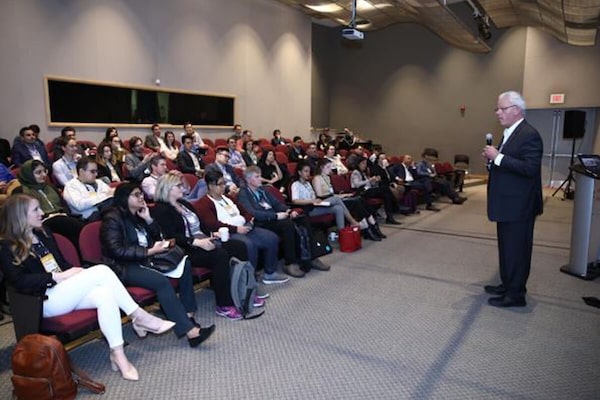
At Siemens, the electricity system of the future is bidirectional, connected, energy efficient, resilient and secure.iStockPhoto / Getty Images
What does the electricity system of the future look like? To Richard Wunderlich, it’s bidirectional, enables connectivity between platforms and people, and is efficient, resilient and secure.
This may sound like a lot to ask for, and the director of Smart Grid Initiatives at Siemens Canada knows it. But nonetheless, he called for radical change during “The electricity grid of the future – no longer your grandpa’s grid,” a talk at Toronto’s Collision tech conference held on May 22, 2019.
Wunderlich says the modern electricity grid needs to be transformed to allow consumers “more flexibility and more interactivity and to particularly address the fact that we are becoming concentrated in cities, that we are getting older, that we are relying on other parts of the world to enable our lifestyles … and that we want to interact more.”
“We want to have a digitalized world,” Wunderlich says. We need a grid that allows that.
Taking a quick audience poll at his talk, Wunderlich discerned the average conference-goer owns 20 devices that are connected to the Internet in some way. Beyond the expected devices such as smartphones, tablets and computers, consumers’ refrigerators, cars, laundry machines and even barbecues, are now becoming connected to the grid.
And the rate at which these consumer goods are innovating is also increasing. Wunderlich estimates the average laptop lasts two years, while the average cellphone lasts 12 months. And this does not account for the even shorter time frame within which updated hardware and software become available – and consumers are called upon to upgrade their devices yet again.
A truly smart grid must be designed with these demands in mind.

Richard Wunderlich presenting about the smart grid and how to create the electricity grid of the future at Collision tech conference in Toronto.Siemens
“Innovation cycles are changing everywhere: they’re getting shorter and shorter, and they’re giving us more opportunities. And we have a high appetite to take advantage of it,” Wunderlich says. The current energy grid is “totally at odds with what we expect as individuals today.”
He says a smart grid must allow for energy to move in two directions: both away from a central power plant, as it is today, and back toward it, from sources of renewable energy across the grid.
“The grid itself is going to become innovative, so that all points of consumption are bidirectional points of consumption informed by your actions, informed by the costs of the energy you’re consuming [and] possibly, with recommendations and algorithmic support for you to reduce or use less.”
Wunderlich also believes a smart grid must be sustainable and secure, capable of withstanding attempts at physical and cyber infiltration, as well as extreme weather events. A smart grid is only powerful if it is resilient, “capable of bouncing back from catastrophic events,” he says.
“We need to get way, way better at planning, simulating, scenario building, algorithm enabling,” Wunderlich said, concluding his talk. “That’s the challenge that we’re faced with as we go toward the electricity system of the future.”
Advertising feature produced by Globe Content Studio. The Globe’s editorial department was not involved.